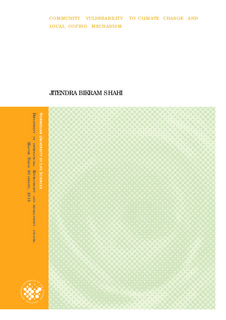| dc.contributor.author | Shahi, Jitendra Bikram | |
| dc.date.accessioned | 2013-09-23T10:52:37Z | |
| dc.date.available | 2013-09-23T10:52:37Z | |
| dc.date.copyright | 2013 | |
| dc.date.issued | 2013-09-23 | |
| dc.identifier.uri | http://hdl.handle.net/11250/187901 | |
| dc.description | local people perception about climate change,effect of climate change experienced by local community was observed. Climatic data of temperature and precipitation of 30 year analyzed and try to interrelate it with people's perception. observation was based on Vulnerability of local people due to different disasters and local adaptive capacity. | no_NO |
| dc.description.abstract | Community Vulnerabilities to climate change and local coping mechanisms at Ramshikharjhala VDC of Kailai
J.B.Shahi
The Ramshikharjhala VDC is located in the Kailali district of the far western Nepal. Total area of this VDC is 157.95 square km and its altitude ranges between 142m to 1474m from sea level.
There were 45.3% Brahmin/Chhetris, 33.6% Tharus and 21.1% others.
Temperature and precipitation data analysis of Ramshikhar Jhala between 1981 to 2010 showed some changes. The mean maximum temperature was increasing at 0.37c per decade where as the mean minimum temperature was increasing at 0.26˚C per decade. Average monthly rainfall shows that November is the driest month with 3.94 mm of average rainfall where as it is 497.3 in July which is the wettest month. The analysis of the seasonal rainfall shows increasing trend in monsoon and decreasing trend in winter which makes the area more prone to water related disasters. Regarding the experience of local inhabitants of that area, more than 90% of
respondents felt the increased frequency of flooding, more than 72% said they have experienced increasing temperature and 88% of respondents have experienced unusual rainfall events.
About 55% of the respondents believed that the agricultural production has decreased. Most of the farmers experienced unusual weather patterns which affect the productivity. They also have
experienced the scarcity of water and more frequent climatic disasters.
“The people in the area did not have local adaptive capacity, so there was a need to formulate adaptive measures for the security of food and dealing with scarcity of water and climate change
induced disasters | no_NO |
| dc.language.iso | eng | no_NO |
| dc.publisher | Norwegian University of Life Sciences, Ås | |
| dc.subject | Climate change vulnerability in Nepal | no_NO |
| dc.subject | Key word: Climate change, Nepal, Terai, Temperature, Precipitation, Disaster, Adaptive capacity, Vulnerability, Experience of local inhabitants, Community, Coping mechanisms. | no_NO |
| dc.title | Community vulnerability to climate change and local coping mechanism | no_NO |
| dc.type | Master thesis | no_NO |
| dc.subject.nsi | VDP::Social science: 200 | no_NO |
| dc.subject.nsi | VDP::Mathematics and natural science: 400::Geosciences: 450 | no_NO |
| dc.source.pagenumber | 40 | no_NO |
